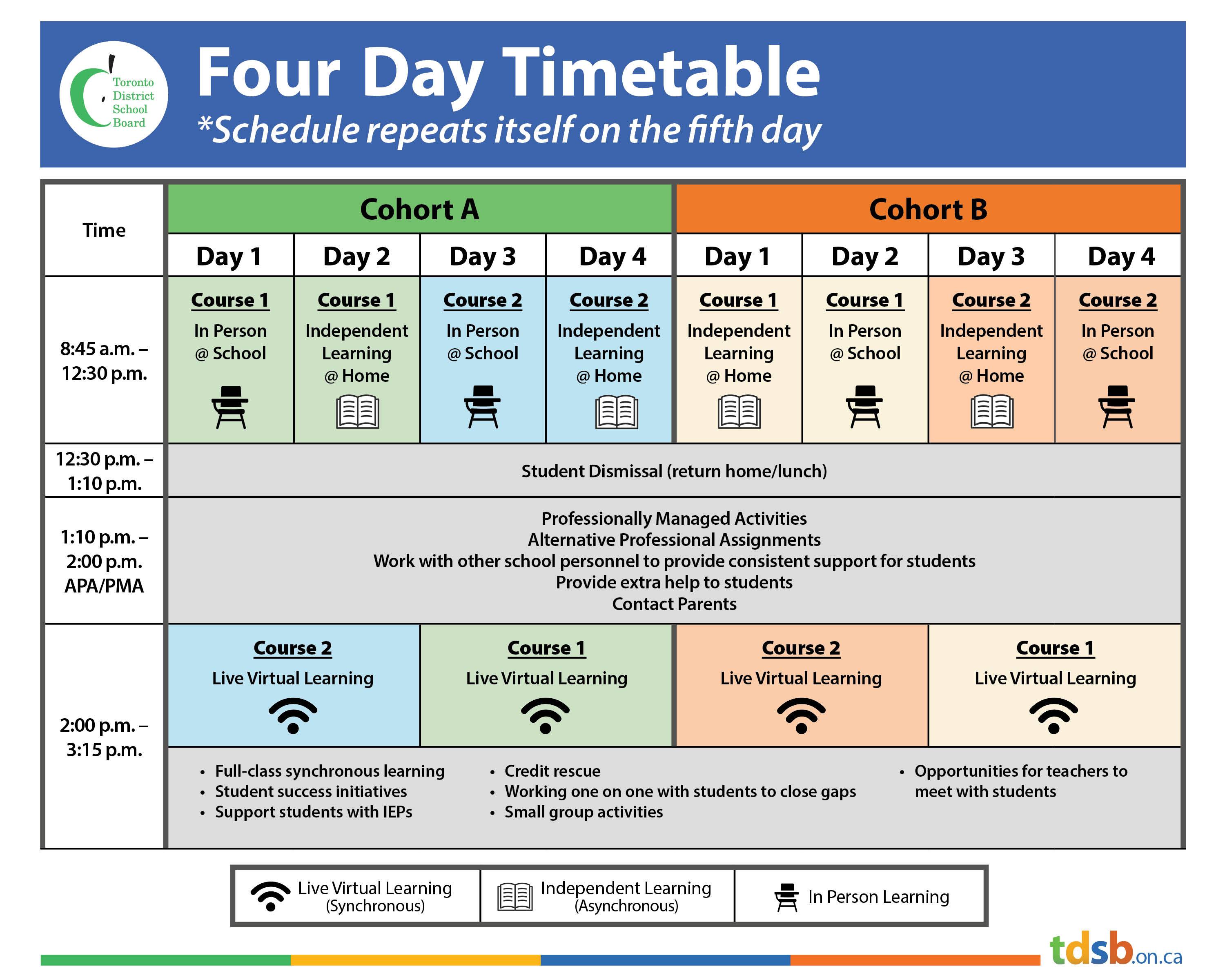Secondary
All secondary students start school on Tuesday, September 15.
Secondary students will return to school in a quadmester format. By breaking the school year down into four blocks -- quadmesters -- students will concentrate on two subjects at a time. This helps reduce potential contact between students and supports health and safety protocols.
At the beginning of each quad students choose between:
- Adapted In-School Day Model (Smaller Class Size Cohorts)
- 100% Remote Learning
Students/parents must indicate their choice two weeks prior to the start of a quad. Switching during quads is not permitted.
TDSB e-Learning Day School Program will continue to be made available in Grades 11 and 12 (contact your school guidance counselor for more details.
Quadmester Calendar
- Quad 1: Sept 15 - Nov. 9 + Exams Nov. 10 and Nov. 11
- Quad 2: Nov. 12 - Jan. 28 + Exams Jan. 29 and Feb. 1
- Quad 3: Feb. 3 - April 19 + Exams April 20-21 *April 8, 2021: OSSLT Day
- Quad 4: April 22 - June 23 + Exams June 24, 25, 28
- PA Days: September 1-3, November 20, February 2, February 12, June 29
Adapted In-School Day Model
Secondary students in the in-school model will be in school with their teacher every other day and will have live video conferencing (synchronous learning) with their teacher daily. Class sizes will be approximately 15 students.
 All courses will use a Brightspace or Google Classroom learning platform. Students will be able to participate in whole class, small group and independent learning. The daily virtual 12:30-2:00 learning period may be used for:
All courses will use a Brightspace or Google Classroom learning platform. Students will be able to participate in whole class, small group and independent learning. The daily virtual 12:30-2:00 learning period may be used for:
- Support for Students with Special Needs, IEPs, ELLs, etc.
- Student Success Initiatives (RCR, caring adult meetings)
- Gap Closing -- Small Group Learning
- School-Wide or Small Group Wellness Initiatives
- Support for IB Program Requirements (Extended Essay, ToK, Internal Assessments)
- Meetings for Leadership Groups (e.g. Student Council, Athletic Council, etc.)
Secondary Virtual Learning
The TDSB Secondary Virtual School will be fully online and staffed by TDSB teachers, a principal, vice-principals, guidance counsellors and support staff. Students will maintain a connection with the school that retains their school records, referred to as their home school. Students will be taking part in synchronous (live/online) learning and asynchronous (independent work) learning throughout the day.
Class Size
Class sizes in the Secondary Virtual School will be the same as those in our in-person model. Class size in secondary schools is determined by the type of course. For example:
Academic - target of 30 students
Applied - target of 23 students
University - target of 31 students
College - target of 26 students
University/College - target of 31 students
Entering From or Returning to In-Person Learning
We recognize that parents/guardians and/or students may want to switch between in-person learning and Virtual School. It is important to note that, for health and safety reasons, and because of the impact switching would have on staffing, physical distancing and space allocation, it will not be possible to immediately transition between the two models. As a result, an opportunity to enter the Virtual School or to return to in-person learning will be provided at the end of each quadmester as follows:
|
Opportunity to Change
|
Date the Change of Class Would Take Effect
|
Deadline for Requesting Change
|
|
End of Quad 1, Start of Quad 2
|
November 12, 2020
|
October 15, 2020
|
|
End of Quad 2, Start of Quad 3
|
February 3, 2021
|
January 5, 2021
|
|
End of Quad 3, Start of Quad 4
|
April 22, 2021
|
March 23, 2021
|
Structure of the Day:
Students may take one or two courses per quadmester. Course 1 will meet online in the morning from 9:00 a.m. to 11:30 a.m. Course 2 will meet online in the afternoon from 1:00 p.m. to 3:30 p.m.
As per the Ministry of Education, teachers in the Virtual School will deliver two hours per course/per day in a synchronous (live, online) format. There will also be time for asynchronous (independent work) learning, which may include small group learning, tutorials, and one-on-one support.
|
9:00 a.m. - 11:30 a.m.
|
Course 1
|
2 hours synchronous
0.5 hour asynchronous/independent work
|
|
1:00 p.m. - 3:30 p.m.
|
Course 2
|
2 hours synchronous learning
0.5 hour asynchronous/independent work
|
Daily attendance will be taken.
Specialized Programs
In order to run a course, approximately 30 students are required. Where possible, courses that make up the components of a Specialized Program in a student’s original in-person school home school will be offered by the Secondary Virtual School.
It may not be possible to have teachers with specialized training (i.e., International Baccalaureate, Advanced Placement) for specific specialty courses.
Graduation/Diplomas
Students who register at the Secondary Virtual School will be able to participate in the graduation activities at their home school. Similarly, the Ontario Secondary School Diploma (OSSD) or Ontario Secondary School Certificate (OSSC) will be issued by the home school.
Learning Management System
Courses in the Secondary Virtual School will be delivered through an online learning platform called Brightspace. Classrooms will use Brightspace to deliver interactive online learning where teachers and students communicate and collaborate using a variety of digital tools: discussions, news, calendar, dropboxes, grades, quizzes, surveys, and more.
For an overview of the online classroom, please visit: https://www.d2l.com/higher-education/products/core/
Student Support Opportunities
All students in the Secondary Virtual School will have access to student support through guidance counselors, special education teachers, social workers, students success teachers, and child and youth counselors.
Devices
Every student in the Virtual School will be required to have a device. For those without access to a device, access will be arranged through the student’s home school through the Principal.